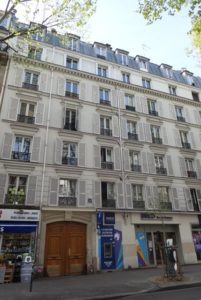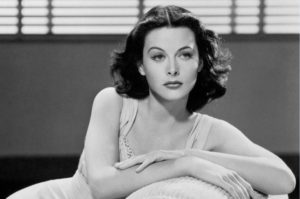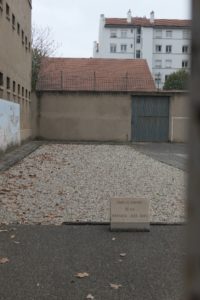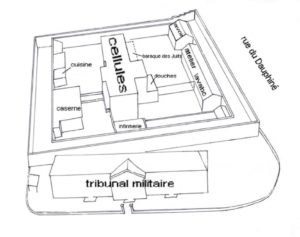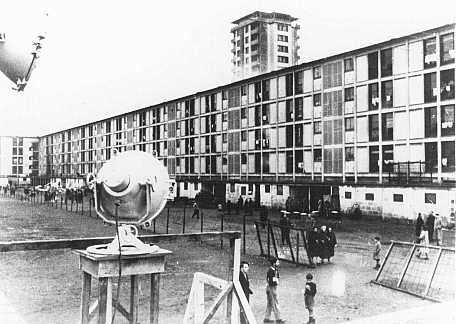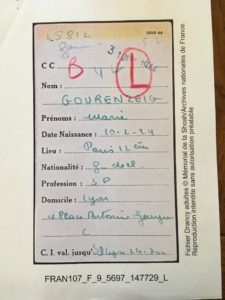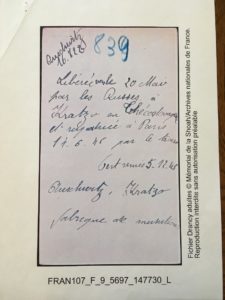Marie GOURENZEIG
To the left, Marie’s birth certificate. Source: Paris Archives
Marie Gourenzeig was born on February 10, 1924 in the 12th district of Paris, France. She spent her childhood at 397 rue des Pyrénées in Paris, a cosmopolitan neighborhood where many different communities lived side by side. She was born into a Polish immigrant family. Their humble but happy family was made up of her father, Nouissen Gourenzeig, born on November 6, 1900, her mother, Rosa Tukir, born on December 29, 1899, her oldest brother Zalo, born on April 12, 1921, her brother Joseph, born on February 8, 1927 and the baby of the family, Paulette, who was born on July 30, 1932.
397 rue des Pyrénées in Paris. Source: Photo by Christèle Vial
Marie was educated at the local school on rue de Belleville, just beside her home. According to her brother Joseph, her school reports were very good20. Also according to Joseph, her frivolous nature helped her to remain unaware of the increasing anti-Semitism. Her sister Paulette describes her as a beautiful young brunette and likens her to the American movie star, Hedy Lamarr. Marie was very interested in movie stars and the cinema, and had pictures of movie stars in her bedroom. She also liked drawing, and Paulette says that she was very artistic.
Hedy Lamarr.
Source: https://www.franceculture.fr/cinema/hedy-lamar
Credits: George Rinhart – Getty
In the spring of 1940, following the German offensive, her father, who sensed the danger, sent her and her entire family to take shelter in a little village not far from Sens, where they stayed with an elderly English woman. However, the family returned to Paris a few days later, before the Germans invaded the capital.
In 1941, Marie, along with all of her family members, lost her French nationality under the terms of the French decree dated July 22, 1940. According to an article in the French newspaper Le Monde: “The law of 1940 […] officially concerned “the revision of naturalizations” but its first section referred to “the revision of all acquisitions of French nationality“. This is quite different, since naturalization and the acquisition of nationality are not at all the same thing. Firstly, in terms of numbers, there are twice as many people who acquire French nationality as those who are naturalized. Secondly, legally, the children of naturalized French parents are born French, whereas naturalized persons are born foreigners”.
After they lost their French citizenship, Marie’s father decided to look for a place to relocate his family in the free zone. Marie left Paris at the age of 17, in 1941. This was the first time that she and her family tried to cross the demarcation line. On the day that they left, Marie’s mother tried to delay their departure because she did not want to leave her home, so to keep the people smuggler waiting, she sent Marie, who was 17, and Paulette, who was 9, to meet him. However, when Joseph, André and their mother arrived at the station, they were unable to find Marie and Paulette, who were supposed to be with the people smuggler. Rosa, Joseph and André therefore got on the train as planned, hoping to find Paulette and Marie, but when they couldn’t find them, their mother decided to get off the train in Dijon and go back to look for the girls. The boys continued on alone on the train.
When she returned to Paris, their mother went back to their apartment at 397 rue des Pyrénées. There, she met up with Marie and Paulette again and there they waited for about two months until the boys came back. They had been arrested when they tried to cross the demarcation line and then detained in Autun jail.
After eight weeks of in jail, Joseph and Andre were reunited with their mother and sisters. Their mother, aware that the police might come at any moment, sent her children to sleep on the sixth floor, in André’s room. The following day, she decided to take them to an aunt’s house on Boulevard Richard Lenoir. Determined and fearless, she hesitated no longer and immediately sought another people smuggler.
On their second attempt, the family again took the train to Lyon. This time, they got off the train just before Chalon-sur-Saône in order to try to cross the demarcation line on foot. The walk to cross the line was hard, because it was wintertime. They walked in the snow for hours, in the cold, during the night. After walking all night, they eventually reached the free zone and knocked on every door of a little hamlet. After several minutes, a peasant woman finally opened her door. She let them into her house and sat them down in front of the fire. However, a short time later, the peasant woman told them that she was going to call the police. A few hours later, the police arrived and questioned the family. They then put the family on a train to Lyon and told them that they were going to notify their father that they were on their way.
The family eventually met up with Noussen who took them to their new apartment. It was at 11 place Antonin Gourju, a few blocks from the Place Bellecour, near the Saône River, in the center of Lyon. Life was quite comfortable there and they sometimes even managed to get butter and eggs on the black market.
On the afternoon of July 18, 1944, Joseph and Marie’s parents were arrested. Marie and André were not arrested immediately because André hid in a closet. Marie, meanwhile, escaped with some workers from her father’s company, Dora and Michel. This was thanks to Joseph, who got involved in an argument with one of the police officers.
A few days later, however, while she was in the apartment, the Gestapo men came back to steal the family’s jewelry and other valuables. It was at this point that Marie was arrested. The family was arrested, interned and deported as a result someone reporting them in an anonymous letter.
From then on, everything happened very quickly. Marie was incarcerated in Montluc jail, at 4 rue Jeanne Hachette in Lyon, until July 24, 1944. Built in 1921, it was initially a military prison but from January 1943 to August 24, 1944, it was used by the Germans. The living conditions were terrible: the cells were about 20 by 20 feet and held 8 to 10 people. The beds were replaced by bags of straw. Each cell had only one bucket that served as a WC and one bowl for washing. For meals, there was only black bread. Prisoners were allowed to go out for just 45 minutes a day. Diseases such as typhus spread rapidly, as did lice, fleas and rats. The prison included the so-called ” Jews’ barracks”, a building of about 100 feet long by 20 feet wide, in the courtyard. The Jews were crammed into this building with no access to washing facilities. This is where Marie’s father and brothers were imprisoned. As for Marie, she was with her mother, and they were probably detained in the prison workshop or in barrack huts.
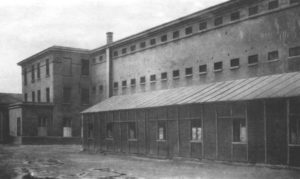
The Jews’ barracks in the main exercise yard
Source: Rhône departmental archives, ref. 4544 W 17
The location of the Jews’ barracks today. Source: Photo by Christèle Vial
Plan of the Montluc prison
Source: http://museedelaresistanceenligne.org/media496-Plan-de-la-prison-de-Montluc-Lyon#fiche-tab
On July 24, 1944, she left Lyon for Drancy camp, to the north of Paris. Drancy was made up of 3 distinct sites, 3 blocks of buildings in the shape of a “U”. The section on the left was for the prisoners detained in cells, who were frequently shot. The section on the right was for people who were to be deported. The middle building was used to hold the Mischlingen, i.e. Aryan men or women who were married to Jews. During the day, they were free to go outside, except for the day before a deportation convoy, when a fence was erected to cordon off the building on the right. The camp gates were guarded by French police. During the Gourenzegs’ internment in the camp, on July 28, 1944 to be precise, the courtyard was fenced off to separate the Jews from the other prisoners. On July 31, 1944, 17 days before the camp was liberated, Marie and her family left Drancy for Auschwitz in Poland. The travelling conditions on the train were appalling: the cars were normally used to transport livestock and hundreds of Jews were crammed into them. Besides that, the prisoners had no food or water during the journey, which lasted three days and two nights. Many unfortunate people died of malnutrition, diseases or suicide. The corpses were intermingled with the people still alive, which made the journey even more traumatic.
Jews interned in Drancy camp, France, between 1941 and 1944
Photo credit: United States Holocaust Memorial Museum
Source: http://www.ajpn.org/images-camps/1287327403_juifs.jpg
When they arrived and got off the train, the SS made a selection. Men were sent to one side, women to the other. Marie’s father and brothers were taken to Auschwitz, while her mother was sent straight to the gas chambers. Marie herself was deemed fit for work. She probably followed the same path as Régine Skorka-Jacubert, who travelled on the same train as her and who said that after the selection, the women were taken to a hut where they had to get undressed and were then shorn and shaved. This probably happened in what was known as the sauna; the disinfection and registration room. After that, Marie and the other women would have taken some old clothes from a pile intended for the prisoners. Together with the other women on her convoy, she was probably then taken to a wooden barrack hut in the former Gypsy camp. To begin with, Marie and her fellow prisoners would have been put in quarantine, which meant that during the day they would have been taken outside the camp to haul stones.
After an unknown period of time in Auschwitz, Marie was transferred to Kratzau. She may have left at the same time as Régine Skorka-Jacubert, on October 28, 1944. Kratzau was a labor and concentration camp in Czechoslovakia where women and men were held together. According to Régine Skorka-Jacubert, the travelling conditions were once again appalling. The women were squeezed together so tightly that they were unable to move. The heat is unbearable and there was no food or water.
The labor camp included several workshops: a paint shop, a factory, an armaments workshop, and a textile works where the prisoners worked up to 12 hours a day, hungry all the time. According to the Drancy file, Marie worked in the munitions factory. Every morning, a roll call was held to check that all the prisoners were present. The Germans were very violent towards the prisoners, both male and female. The women in the camp had little clothing and dressed themselves in anything they could find. According to Regina Skorka-Jacubert’s testimony, there were big differences between nationalities and religions. The Jews were the ones who were mistreated the most. All of the prisoners in this camp were undernourished and suffered from a lack of sleep. The work itself was not particularly unpleasant, but it was very demanding due to the hunger and fatigue. When the work was carried out correctly and exceeded the expectations, bonuses were awarded. These bonuses were often given in the form of slightly larger quantities of food such as jam, milk and margarine. In terms of sanitation, the women in the camp had great difficulty in washing both themselves and their clothes. They had to make do with a cursory wash in the factory where they worked, where water was available. They had no soap or detergent rations. Some women ended up with severe eczema because they were unable to wash properly after handling fuel oil. Numerous diseases occurred due to the poor living conditions, such as phlegmon, enteritis, severe diarrhea and various others.
According to the Drancy file, the Kratzau camp was liberated around May 20, 1945 by the Russians and Marie was repatriated to France by train on either June 14 or June 22.
Extract from the Drancy file. Source: Shoah Memorial archives (references shown on the records)
When Marie got back to Paris, Joseph met up with her one day in a public canteen, thanks to two of his friends Max and Henri, who left him alone to talk with his sister. It was a very emotional reunion. Marie told him how she had escaped from one of the camps and all about what her time in Germany had been like.
Joseph offered to take her to live with him in his apartment, but living together soon proved difficult. Marie was traumatized after having been deported and imprisoned in various different camps. She became aggressive every time they talked and Joseph did not understand why.
Having found Marie, Joseph wanted to rescue Paulette as well. They discussed this idea but Marie refused to go with him to Villefranche-sur-Saône, where some farmers were taking care of their little sister.
He decided to go alone, but when he got there the host family tried to convince him that Paulette was doing well with them. Eventually, Joseph returned to Paris together with Paulette and the pair were reunited with Marie, but again, once the emotion of the occasion had subsided, the tension returned, and living with Marie proved to be problematic.
One day, when Joseph came home from work, he found Paulette crying. She told him that Marie had hit her. Joseph was furious and lashed out at his sister, who rushed to the police department to file a complaint. The police commissioner realized that Marie had been deeply traumatized by the abuse she had suffered in the camps. It is possible, based on some other deportees’ testimonies that she may have been raped. The police chief suggested to Joseph that he sign an order to have Marie committed to a psychiatric hospital in order to distance himself from her. However, Joseph chose instead to look for an apartment for her in order to improve their relationship. Marie moved to an apartment on rue Vignon, not far from the church at la Madeleine, in Paris where she lived for the rest of her life.
From then on they lost contact and there is little information available about Marie. According to Paulette, Marie never married and had no children. She spent her time painting, and led a Bohemian lifestyle. Paulette secretly helped her to support herself financially, for example by sending people to buy her paintings.
Even though Marie survived, the traumatic events that she endured left her devastated. After the war, Joseph and Paulette lost their big sister for the rest of their lives.


 Français
Français Polski
Polski
